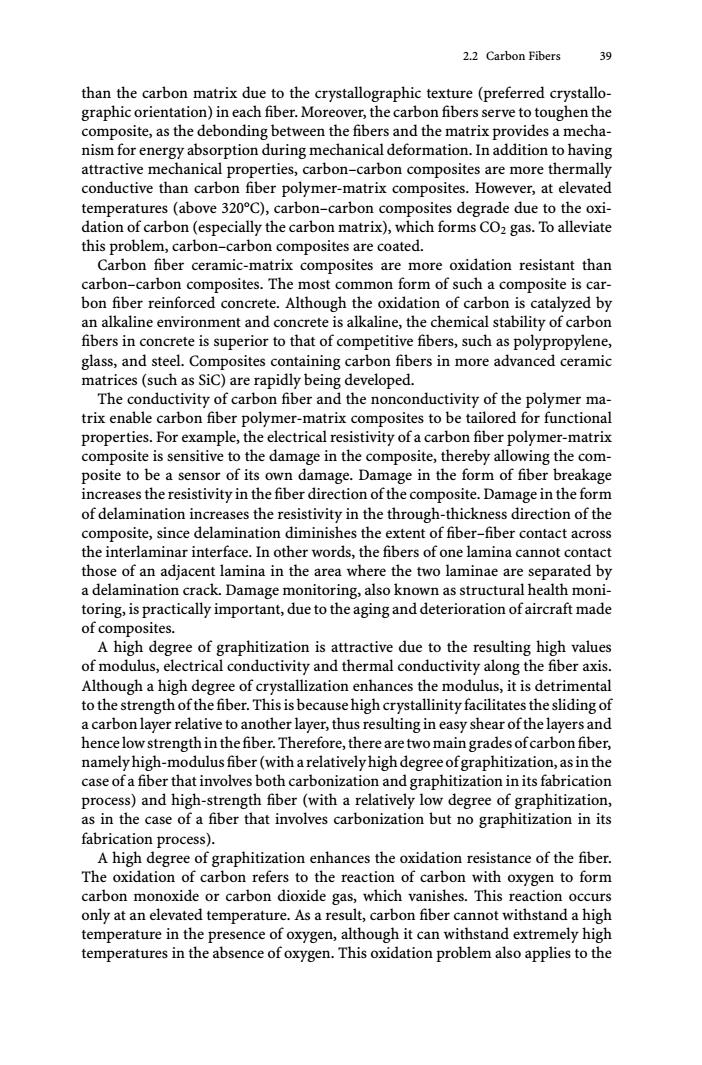正在加载图片...

2.2 Carbon Fibers 39 than the carbon matrix due to the crystallographic texture (preferred crystallo- graphic orientation)in each fiber.Moreover,the carbon fibers serve to toughen the composite,as the debonding between the fibers and the matrix provides a mecha- nism for energy absorption during mechanical deformation.In addition to having attractive mechanical properties,carbon-carbon composites are more thermally conductive than carbon fiber polymer-matrix composites.However,at elevated temperatures(above 320C),carbon-carbon composites degrade due to the oxi- dation of carbon(especially the carbon matrix),which forms CO2 gas.To alleviate this problem,carbon-carbon composites are coated. Carbon fiber ceramic-matrix composites are more oxidation resistant than carbon-carbon composites.The most common form of such a composite is car- bon fiber reinforced concrete.Although the oxidation of carbon is catalyzed by an alkaline environment and concrete is alkaline,the chemical stability of carbon fibers in concrete is superior to that of competitive fibers,such as polypropylene, glass,and steel.Composites containing carbon fibers in more advanced ceramic matrices (such as SiC)are rapidly being developed. The conductivity of carbon fiber and the nonconductivity of the polymer ma- trix enable carbon fiber polymer-matrix composites to be tailored for functional properties.For example,the electrical resistivity of a carbon fiber polymer-matrix composite is sensitive to the damage in the composite,thereby allowing the com- posite to be a sensor of its own damage.Damage in the form of fiber breakage increases the resistivity in the fiber direction of the composite.Damage in the form of delamination increases the resistivity in the through-thickness direction of the composite,since delamination diminishes the extent of fiber-fiber contact across the interlaminar interface.In other words,the fibers of one lamina cannot contact those of an adjacent lamina in the area where the two laminae are separated by a delamination crack.Damage monitoring,also known as structural health moni- toring,is practically important,due to the aging and deterioration of aircraft made of composites. A high degree of graphitization is attractive due to the resulting high values of modulus,electrical conductivity and thermal conductivity along the fiber axis. Although a high degree of crystallization enhances the modulus,it is detrimental to the strength of the fiber.This is because high crystallinity facilitates the sliding of a carbon layer relative to another layer,thus resulting in easy shear of the layers and hence low strength in the fiber.Therefore,there are two main grades ofcarbon fiber, namely high-modulus fiber(with a relatively high degree ofgraphitization,as in the case of a fiber that involves both carbonization and graphitization in its fabrication process)and high-strength fiber(with a relatively low degree of graphitization, as in the case of a fiber that involves carbonization but no graphitization in its fabrication process). A high degree of graphitization enhances the oxidation resistance of the fiber. The oxidation of carbon refers to the reaction of carbon with oxygen to form carbon monoxide or carbon dioxide gas,which vanishes.This reaction occurs only at an elevated temperature.As a result,carbon fiber cannot withstand a high temperature in the presence of oxygen,although it can withstand extremely high temperatures in the absence of oxygen.This oxidation problem also applies to the2.2 Carbon Fibers 39 than the carbon matrix due to the crystallographic texture (preferred crystallographic orientation) in each fiber. Moreover, the carbon fibers serve to toughen the composite, as the debonding between the fibers and the matrix provides a mechanism for energy absorption during mechanical deformation. In addition to having attractive mechanical properties, carbon–carbon composites are more thermally conductive than carbon fiber polymer-matrix composites. However, at elevated temperatures (above 320°C), carbon–carbon composites degrade due to the oxidation of carbon (especially the carbon matrix), which forms CO2 gas. To alleviate this problem, carbon–carbon composites are coated. Carbon fiber ceramic-matrix composites are more oxidation resistant than carbon–carbon composites. The most common form of such a composite is carbon fiber reinforced concrete. Although the oxidation of carbon is catalyzed by an alkaline environment and concrete is alkaline, the chemical stability of carbon fibers in concrete is superior to that of competitive fibers, such as polypropylene, glass, and steel. Composites containing carbon fibers in more advanced ceramic matrices (such as SiC) are rapidly being developed. The conductivity of carbon fiber and the nonconductivity of the polymer matrix enable carbon fiber polymer-matrix composites to be tailored for functional properties. For example, the electrical resistivity of a carbon fiber polymer-matrix composite is sensitive to the damage in the composite, thereby allowing the composite to be a sensor of its own damage. Damage in the form of fiber breakage increases the resistivity in the fiber direction of the composite. Damage in the form of delamination increases the resistivity in the through-thickness direction of the composite, since delamination diminishes the extent of fiber–fiber contact across the interlaminar interface. In other words, the fibers of one lamina cannot contact those of an adjacent lamina in the area where the two laminae are separated by a delamination crack. Damage monitoring, also known as structural health monitoring, is practically important, due to the aging and deterioration of aircraft made of composites. A high degree of graphitization is attractive due to the resulting high values of modulus, electrical conductivity and thermal conductivity along the fiber axis. Although a high degree of crystallization enhances the modulus, it is detrimental to the strength of the fiber. This is because high crystallinity facilitates the sliding of a carbon layer relative to another layer, thus resulting in easy shear of the layers and hencelowstrengthinthefiber.Therefore,therearetwomaingradesofcarbonfiber, namelyhigh-modulusfiber(witharelativelyhighdegreeofgraphitization,asinthe case of a fiber that involves both carbonization and graphitization in its fabrication process) and high-strength fiber (with a relatively low degree of graphitization, as in the case of a fiber that involves carbonization but no graphitization in its fabrication process). A high degree of graphitization enhances the oxidation resistance of the fiber. The oxidation of carbon refers to the reaction of carbon with oxygen to form carbon monoxide or carbon dioxide gas, which vanishes. This reaction occurs only at an elevated temperature. As a result, carbon fiber cannot withstand a high temperature in the presence of oxygen, although it can withstand extremely high temperatures in the absence of oxygen. This oxidation problem also applies to the